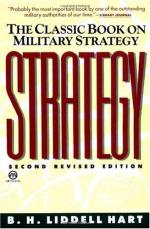
|
| Name: _________________________ | Period: ___________________ |
This test consists of 5 short answer questions, 10 short essay questions, and 1 (of 3) essay topics.
Short Answer Questions
1. Which of the following best defines military strategy?
2. What is one of the main advantages of a large army?
3. Late in the war, the primary German leader in the east was allowed to employ the indirect method by using what kind of an attack?
4. In what strategic realm did Hitler fail?
5. Clausewitz himself admitted that his books had what flaw?
Short Essay Questions
1. What is a wedge attack, what is it used for and how is it countered?
2. How does policy relate to national object and military aims?
3. What were the results and casualty rates on the Southeastern and Mediterranean fronts during the First World War?
4. What is the principle of flexibility?
5. What did Germany need in order to become secure and peacefully end the war?
6. What causes generals to overstep the bounds of "limited aim" warfare?
7. How did Hitler's study of Napoleon negatively influence him?
8. Explain the relationships between grand strategy, strategy and tactics.
9. Describe the strategies used by the Turks during the First World War.
10. According to the author, what were some motivating factors behind writing this book?
Essay Topics
Write an essay for ONE of the following topics:
Essay Topic 1
Alexander the Great of Macedon is one of the most famed generals in history. His tactical maneuvers in battle are still studied to this day, but he was also a genius in the field of grand strategy.
Part 1) Explain Alexander's grand strategic goal, and his father's influence in creating and defining this goal.
Part 2) Find and explain one example of Alexander using the direct method of full scale combat to achieve part of his grand strategy.
Part 3) Find and explain an example of Alexander using indirect methods to forward his grand strategy. Explain why this action was indirect, and specifically how it advanced part of Alexander's overall goals.
Part 4) Explain at least one example of a long-lasting benefit gained through one of Alexander's decisive victories.
Part 5) Assess Alexander's accomplishments from a strategic standpoint and explain how successful he was in planning and executing his grand strategy.
Essay Topic 2
The "center" of a military force is a crucially important concept in the indirect approach. The identification and dislocation of the enemy center is the very essence of the strategy laid out and endorsed by the author.
Part 1) What is the "center" of a military force. What factors contribute to this center?
Part 2) How is the center of a military force identified. Cite examples of military forces from the book and explain what or where their centers are.
Part 3) How can the center of a military force be dislocated? What are the results of this dislocation? Does the dislocation always involve the destruction of enemy forces? Cite examples from the book of the consequences of the dislocation of a military force's center.
Essay Topic 3
William of Normandy exemplified the skilled military commander of the medieval era. His conquests changed the face of England forever.
Part 1) Explain the background of William of Normandy's invasion of England, including a discussion of his allies and their importance.
Part 2) Discuss one or more of William's most famous battles. How did these battles demonstrate the level of sophistication of strategies of the time?
Part 3) Did William achieve decisive or indecisive results? In either case, what strategic conditions contributed to these results? Explain the nature and importance of these results.
|
This section contains 1,087 words (approx. 4 pages at 300 words per page) |

|




